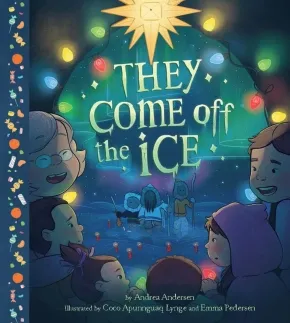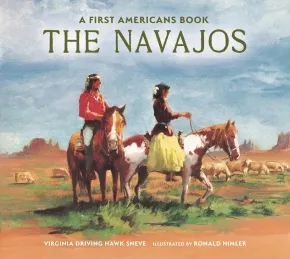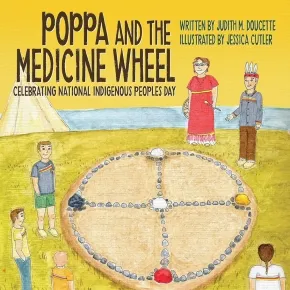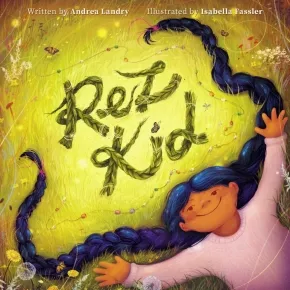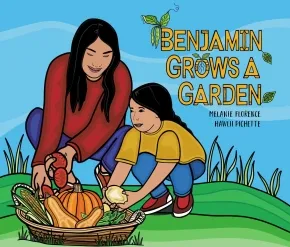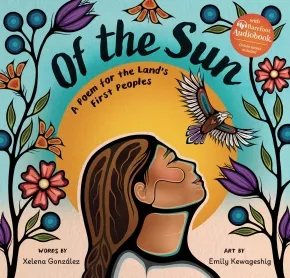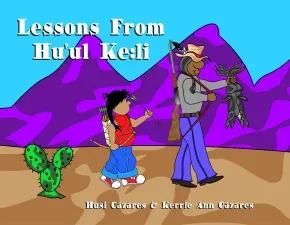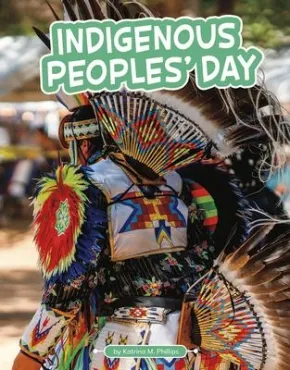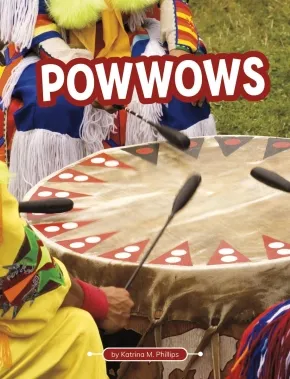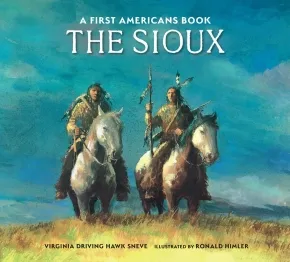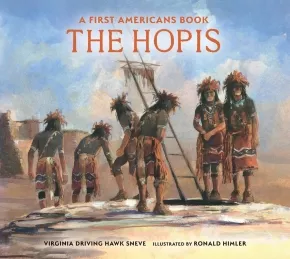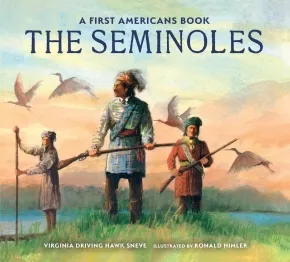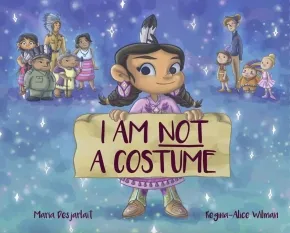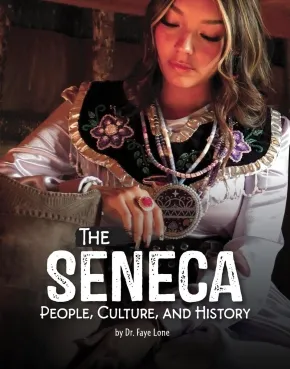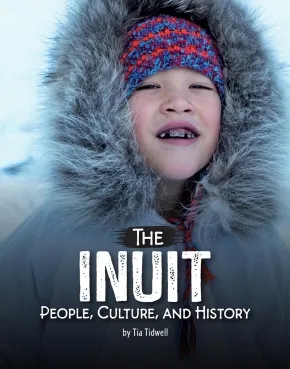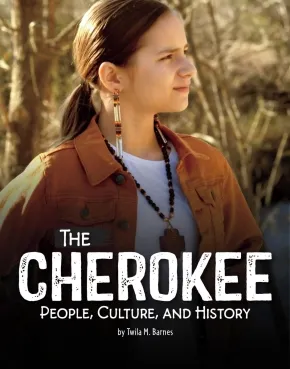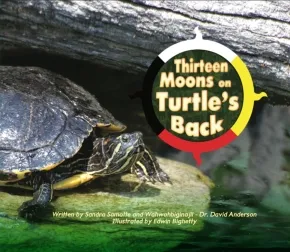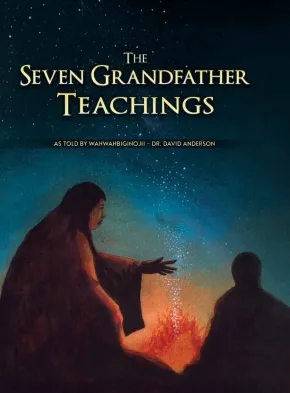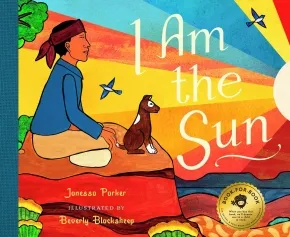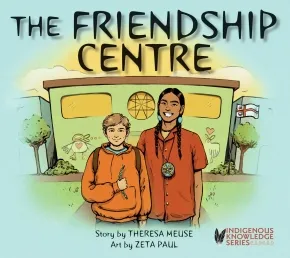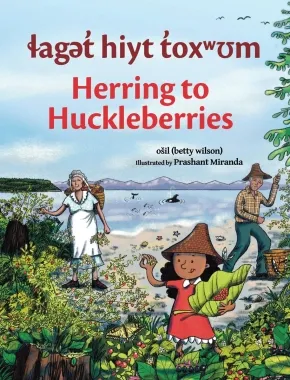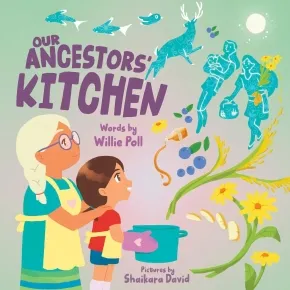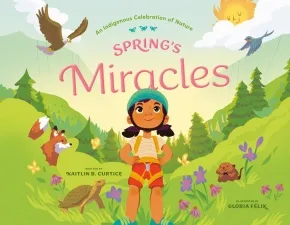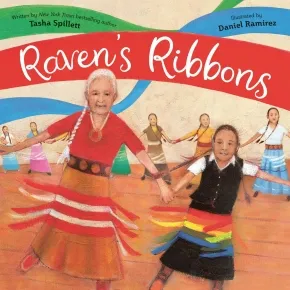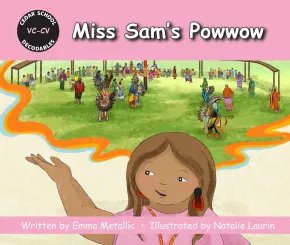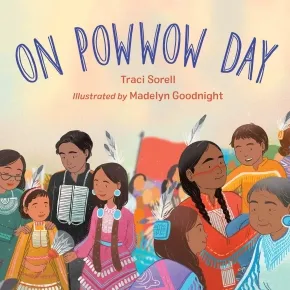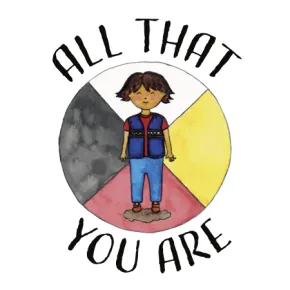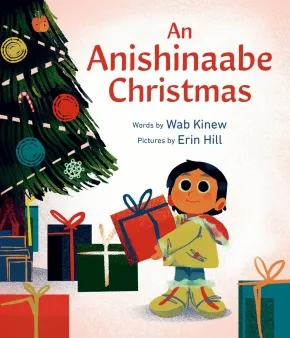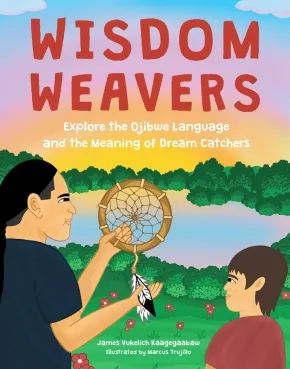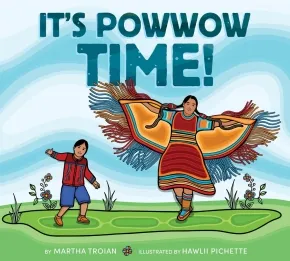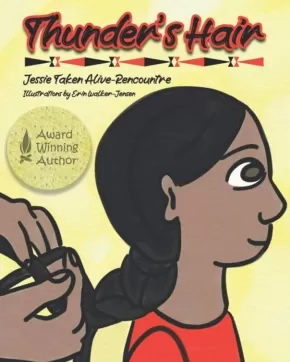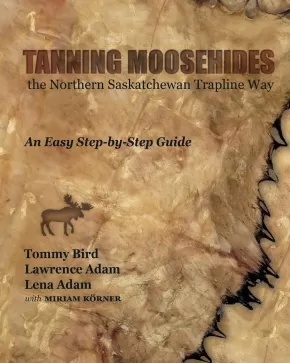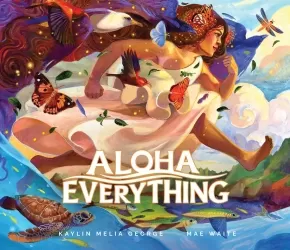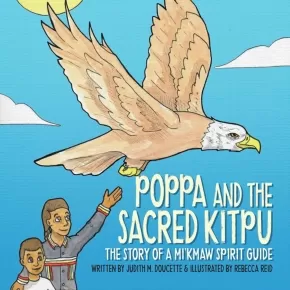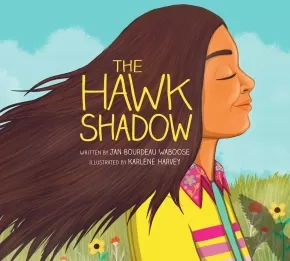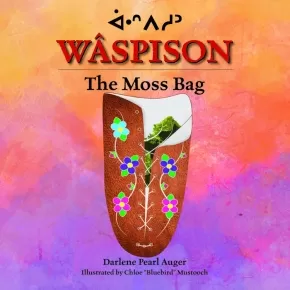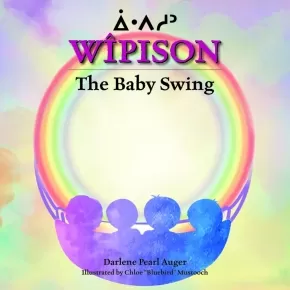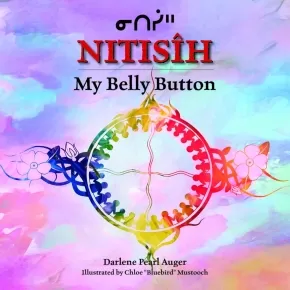
Indigenous Cultural Practices
1
-
15
of
205 Results;
Sort By
Go To
of 14
They Come Off the Ice
$22.95
Artists:
Format:
Hardcover
Text Content Territories:
Indigenous Canadian; Inuit;
ISBN / Barcode: 9781772276442
Synopsis:
Synopsis:
Learn about Nalijuit night, also known as Old Christmas night, a tradition in Inuit communities across Labrador!
In They Come Off the Ice, debut Inuit author Andrea Andersen introduces young readers to a unique celebration that takes place in Inuit communities across Labrador: Nalujuit night!
Each January 6th, also known as Old Christmas night, something comes lurking off the ice and into town. With their faces hidden, long sticks in their hands, and carrying bags full of . . . candy? The beings approach in the snowy darkness. What do they want?
Knock, Knock, Knock
Open the door if you dare!
Educator Information
Recommended for ages 6 to 8.
Additional Information
40 pages | 8.50" x 9.50" | Hardcover
The Navajos
$13.99
Artists:
Format:
Paperback
Text Content Territories:
Indigenous American; Native American; Navajo (Diné);
ISBN / Barcode: 9780823460984
Synopsis:
Synopsis:
In this new and updated edition, award-winning author Virginia Driving Hawk Sneve introduces young readers to the Navajo peoples.
Did you know that Navajo children were given their own lambs to signal their transition into adulthood? Learn about the Navajo’s creation story, resistance and resilience against Spanish colonizers, forked-stick hogan homes, sand paintings, and more.
Expertly reviewed by a member of the Navajo tribe, this updated edition provides the most up to date and accurate information on the Navajo people of the past and present. Historical information is accompanied by a section on modern life and contemporary photos
Educator & Series Information
Recommended for ages 7 to 10.
This book is part of the First Americans series.
Additional Information
32 pages | 10.50" x 9.50" | Paperback
Poppa and the Medicine Wheel
$18.95
Format:
Paperback
ISBN / Barcode: 9781774572535
Synopsis:
Synopsis:
June 21 is celebrated all over Turtle Island (North America) as National Indigenous People’s Day. François and his friends are excited to celebrate their first public commemoration of this day with Poppa. They will host a morning sunrise ceremony, including Poppa’s teaching on the Seven Lessons of the Mi’kmaw Medicine Wheel.
In this third book of the “Poppa” series, Poppa celebrates his first National Indigenous People’s Day with his Mi’kmaw Community of St. George’s, Newfoundland and Labrador. He can finally do so without fear of discrimination or oppression. After many years of having to hide his Indigenous ancestry, due to the colonial assimilation of his generation, Poppa’s grandson, François, invites him to his school as a respected Mi’kmaw Elder.
Poppa realizes with much joy that his Indigenous culture is bursting with revitalization and renewed pride in a heritage he feared would be lost and forgotten forever. He does not have to practise his cultural ceremonies in private any longer.
Come, join us as we rediscover the teachings of our Mi’kmaw Medicine Wheel and how our ancestors depended on it as a valuable teaching tool for our Peoples. The lessons of the Medicine Wheel are deeply profound and rich with Indigenous spirituality. The Medicine Wheel begs the utmost respect for the Creator as well as every other living creature in existence.
We are all connected in this great circle of life, and we are encouraged to share in each other’s life journey with the help of our Spirit Guides and ancestors’ guidance. Poppa invites us to participate in celebrating the joy of this day with him. Let’s all seek to find our own balance and reconciliation with love and acceptance that can be found within the realms of our own Mi’kmaw Medicine Wheel.
Educator & Series Information
Recommended for ages 5 to 12.
This book is part of the Poppa series.
Additional Information
32 pages | 8.50" x 8.50" | Paperback
Grandmother Moon
$25.99
Artists:
Format:
Hardcover
Text Content Territories:
Indigenous American; Native American; Schaghticoke;
ISBN / Barcode: 9781506487038
Synopsis:
Synopsis:
"Nohhum, doesn't it look like the moon is following us?"
During her weekly car ride with her grandmother from the city to the reservation, a young Native girl ponders the moon that seems to follow them. Each week, she looks forward to listening to her grandmother's warm, soothing voice as she sings and tells stories. Tonight, her grandmother teaches her about Grandmother Moon, her significance, and why we honor her.
In her debut picture book, Wunneanatsu Lamb-Cason (Schaghticoke/HoChunk) captures a grandmother and grandchild's relationship through their shared wonder and admiration. Along with rich illustrations, Grandmother Moon preserves Indigenous histories and teachings within a modern setting, reminding us that Grandmother Moon is always watching over us, and wherever we are, we are safe and loved.
Backmatter includes an author's note and more, to learn about the different names of the full moons throughout the lunar year.
Reviews
"A beautiful glimpse into Native storytelling traditions and intergenerational family ties.... VERDICT A solid choice for libraries needing books on Indigenous populations or looking for an introduction to Native belief systems." --School Library Journal
Educator Information
Recommended for ages 4 to 8.
Themes, Subjects & Keywords: Moon, Family, Giving Thanks - Tobacco Offerings, Thirteen Moons on Turtle's Back, Lunar Calendar, Importance of Stories - Storytelling.
Additional Information
32 pages | 10.25" x 8.75" | Hardcover
Rez Kid
$21.99
Artists:
Format:
Hardcover
Text Content Territories:
Indigenous Canadian; First Nations; Anishinaabeg;
ISBN / Barcode: 9781525311253
Synopsis:
Synopsis:
A celebration of traditional ways of life and the power of sharing what we have.
”Rez kid!“ The girl ignores the taunt as she hurries to the back of the school bus. She just wants to get home to the reservation, where she can feel safe. One by one, she tells her mom, nóhkom, moshum and aunty about what happened. And one by one they offer her advice on what to do. Each one has a different idea, but each idea is the same at heart: share something from the reservation with the other children. The girl listens, but decides to come up with her own idea. And, as with everything else about her life as a rez kid, her idea grows out of all she has been given by those who came before her.
Andrea Landry has written a beautiful story that celebrates Indigenous ways of life and encourages readers to be proud of who they are. The traditions practiced on the girl’s reservation are showcased as she beads, harvests medicine, gardens and rides horseback with her elders. Isabella Fassler’s stunning art, with swirls of bold colors, evokes the majesty and splendor of nature. The message of showing kindness in response to aggression offers a powerful lesson for all readers. This book could augment social studies lessons on Indigenous cultures and character education conversations about courage, compassion and inclusiveness. An author’s note gives a brief history of reservations/reserves.
Educator Information
Recommended for ages 4 to 7.
Curriculum Connections: Compassion; Courage; Empathy; Inclusiveness; Indigenous peoples; Rural communities
Additional Information
32 pages | 10.00" x 10.00" | Hardcover
Benjamin Grows a Garden
$21.99
Artists:
Format:
Hardcover
Text Content Territories:
Indigenous Canadian; First Nations; Cree (Nehiyawak);
ISBN / Barcode: 9781525303210
Synopsis:
Synopsis:
Readers follow along step-by-step as Benjamin plants and cares for his garden and imagines the harvest to come.
Benjamin loves springtime. The grass grows bright green, the birds sing sweet songs and, best of all, Benjamin and his mother start their garden. In just the right order, they plant mahtâmin (corn), pîmiciwacis (beans), and osawipak (squash) for Three Sisters Soup. They plant strawberries to serve with bannock, then zucchini, tomatoes, cucumbers. Benjamin and his mom lovingly tend to the garden and watch it grow into a plentiful harvest with enough to share. Throughout the whole summer, Benjamin dreams about the fall, when they’ll have all the ingredients for a feast – and everyone will be invited!
In this heartwarming story, award-winning author Melanie Florence evocatively portrays the pleasures and rewards of growing and sharing food. The steps of the gardening process – digging holes, planting seeds, watering – are carefully described, and the yearly cycle of growing, harvesting, eating and then starting again the next year is emphasized. Special attention is paid to the tradition of planting corn, beans and squash together so that each plant by its nature helps the others grow. Benjamin and his mother use Cree words throughout the story, and a pronunciation guide is included at the back of the book for further inquiry. Vivid illustrations by Hawlii Pichette make this a perfect follow-up to the author and illustrator duo’s previous book, Benjamin’s Thunderstorm.
Reviews
"A comforting tale of cohabitation between humans and nature." — School Library Journal, April 2025
Educator Information
Recommended for ages 3 to 7.
Includes Cree words throughout the story. A pronunciation guide is included at the back of the book.
Curriculum Connections: Caring; Growth and changes in plants; Indigenous peoples; Patience; Plants; Word recognition
This book is part of the Benjamin Outdoors series. From dancing in the rain with thunder for a drum to planting a vegetable garden with his mom, Benjamin loves being in nature. With evocative text and vibrant art, this delightful picture book series celebrates the joys of spending time outdoors and weaves in nature-related Cree words.
Additional Information
40 pages | 10.00" x 8.50" | Hardcover
Of the Sun: A Poem for the Land's First Peoples
$22.99
Format:
Hardcover
Text Content Territories:
Indigenous American; Indigenous Canadian; Indigenous Caribbean; Indigenous Peoples in Mexico; Indigenous South American;
Grade Levels: Preschool; Kindergarten;
ISBN / Barcode: 9798888596500
Synopsis:
Synopsis:
A powerful and hopeful ode to Indigenous children.
Indigenous. Native. On this land, you may roam.
Child of the sun, on this land, you are home.
Of the Sun is an uplifting and mighty poem that wraps the Indigenous children of the Americas in reassuring words filled with hope for a brighter future and reminders of their bond and importance to the land. Each page fills them with pride and awe of their cultural heritage and invites them to unite and inspire change in the world.
Paired with powerful art reflecting cultures of various Indigenous Nations and Tribes, the poem offers all readers a sense of the history and majesty of the land we live on and how we can better care for ourselves and the world when we recognize our connection to the land and to each other.
Written by Xelena González, poet and activist in the Native and Latinx communities, and an enrolled member of the Tap Pilam Coahuiltecan Nation. Bold illustrations by prominent Anishinaabe illustrator Emily Kewageshig depict landscapes across the Americas and children from many backgrounds
Endnotes provide more information on Native and Indigenous unity and activism in younger generations
Reviews
"Of The Sun is a loving homage to the Indigenous peoples of this land—both in González’s beautiful, lyrical poem and Kewageshig’s warm, vibrant Anishinaabe-styled artwork. A wonderful read aloud you must add to bookshelves at home, at school, and in community!" - Traci Sorell, award-winning author of We Are Grateful Otsaliheliga and At The Mountain’s Base
"A luminous song, poem, promise
of cultures and connection,
of kinship and caring,
for Indigenous children across the continent." - Cynthia Leitich Smith, author of Jingle Dancer
Educator Information
Recommended for ages 3 to 5.
Subjects / Themes / Topics Included: Indigenous Peoples in the Americas; Poetry; Land Connection; Inuit Clothing; Traditional Hair Bun (tsiiyéél); Concheros Dance; Three Sisters; La Danza de la Flor de Piña; Smoke Dance; Jingle Dress Dance; Manoomin (Wild Rice); English Words from Indigenous Languages; Indigenous Farming Practices; Bison; Land Back Movement.
Additional Information
32 pages | 10.00" x 9.75" | Hardcover
Lessons From Hu'ul Ke:li
$19.95
Artists:
Format:
Hardcover
Text Content Territories:
Indigenous American; Native American; Tohono O'oodam;
ISBN / Barcode: 9798992176315
Synopsis:
Synopsis:
How a young boy is raised by his grandfather on the Tohono O'odham Indian Reservation. The book denotes various aspects of O'odham himdag (culture) and begins with a simple question that the boy asks his Hu'ul Ke:li (Grandfather) with a culturally relevant answer as to why they do the things they do during the day. Various activities include waking up early in the morning and asking why they do so - to daily chores and activities such as tending horses, working in the garden, hauling water, and gathering food/medicine in the desert.
Educator & Series Information
Recommended for ages 3 to 5 by the publisher, but this book contains a lot of text and may be more suitable for older children.
This book includes many O'odham words, but it is not a dual-language book. A glossary is included.
This book is part of the Tohono O'odham series.
Subjects / Themes: Family, Daily Life, Health, Home, Culture
Additional Information
48 pages | 11.00" x 9.00" | colour illustrations | Hardcover
A Day With Hu'ul
$19.95
Artists:
Format:
Hardcover
Text Content Territories:
Indigenous American; Native American; Tohono O'oodam;
ISBN / Barcode: 9798992176308
Synopsis:
Synopsis:
Grandmother, Why do we do the things we do?
How a young girl is raised by her grandmother on the Tohono O'odham Indian Reservation. The book denotes various aspects of O'odham himdag (culture) and begins with waking up in the morning and then preparing for the day and engaging in several different responsibilities. Various daily chores and activities such as preparation of different food, basket weaving, pottery making, household chores and cultural undertakings are highlighted.
Educator & Series Information
Recommended for ages 3 to 5 by the publisher, but this book contains a lot of text and may be more suitable for older children.
This book includes many O'odham words, but it is not a dual-language book. A glossary is included. O'odham is a Native American language spoken by several tribes in the American Southwest and Northern Sonoran Mexico.
This book is part of the Tohono O'odham series.
Subjects / Themes: Daily Life, Home, Family, Community, Culture
Additional Information
48 pages | 11.00" x 9.00" | colour illustrations | Hardcover
Indigenous Peoples' Day
$11.99
Format:
Paperback
Text Content Territories:
Indigenous American;
ISBN / Barcode: 9781663926340
Synopsis:
Synopsis:
Indigenous Peoples' Day is about celebrating! The second Monday in October is a day to honor Native American people, their histories, and cultures. People mark the day with food, dancing, and songs. Readers will discover how a shared holiday can have multiple traditions and be celebrated in all sorts of ways.
Awards
- 2022 American Indian Library Association winner
Educator Information
Recommended for ages 5 to 8.
This book is about Indigenous Peoples' Day in the United States.
Additional Information
32 pages | 7.00" x 9.00" | Paperback
Powwows
$11.99
Format:
Paperback
Text Content Territories:
Indigenous American; Native American;
ISBN / Barcode: 9798875220005
Synopsis:
Synopsis:
Powwows are about dancing! Indigenous people in America come together at powwows to celebrate their culture and traditions with drumming, singing, and dancing. Together they remember their history and honor their ancestors. Dancers show off their best moves and fancy regalia in dances that tell stories or remember important moments in history. Lively photos and easy-to-read text help readers learn about contemporary powwow dances and traditions and their roots in the past. Readers will discover how Indigenous traditions honor the past and celebrate the present.
Educator Information
Recommended for ages 5 to 8.
Additional Information
32 pages | 7.00" x 9.00" | Paperback
The Sioux
$12.49
Artists:
Format:
Paperback
Text Content Territories:
Indigenous American; Native American; Sioux;
ISBN / Barcode: 9780823460953
Synopsis:
Synopsis:
Award-winning author Virginia Driving Hawk Sneve introduces young readers to the Sioux peoples.
The buffalo was the center of Sioux life. After hunting buffalo on horseback, the Sioux people would use every piece of the animal, making food, beds, clothing, storage boxes, and even sleds from the ribs! Discover how the Sioux people lived on the Great Plains with this accessible introduction. Learn about the Sioux creation story, life in the village as a kid, the importance of their feathered headdresses, and more.
This updated edition provides the most up to date and accurate information on the Sioux people of past and present. The back of the book includes a section on Sioux life today, proper names for all of the Sioux tribes, and an excerpt from the Lakota pipe ceremony.
Educator & Series Information
Recommended for ages 7 to 10.
This book is part of the First Americans series.
Additional Information
32 pages | 10.55" x 9.47" | Paperback
The Nez Perce
$12.49
Artists:
Format:
Paperback
Text Content Territories:
Indigenous American; Native American; Nez Percé (Nimi’ipuu);
ISBN / Barcode: 9780823460960
Synopsis:
Synopsis:
Award-winning author Virginia Driving Hawk Sneve introduces young readers to the Nez Perce peoples.
Did you know that the Nez Perce believed that humans had to seek a spirit helper to find their purpose in life through a vision? Learn about the Nez Perce’s creation story, history, belief, daily ways of living, introduction to the horse, and more in this accessible introduction.
Expertly reviewed by a member of the Nez Perce tribe, this updated edition provides the most up to date and accurate information on the Nez Perce people of the past and present. Historical information is accompanied by a letter from a member of the Nez Perce tribe and a section on modern life.
Educator & Series Information
Recommended for ages 7 to 10.
This book is part of the First Americans series.
Additional Information
32 pages | 10.5" x 9.5" | Paperback
The Hopis
$12.49
Artists:
Format:
Paperback
Text Content Territories:
Indigenous American; Native American; Hopi;
ISBN / Barcode: 9780823460946
Synopsis:
Synopsis:
Award-winning author Virginia Driving Hawk Sneve introduces young readers to the Hopi people.
Did you know that the Hopi people have always lived on three mesas, big flat-topped hills, in Arizona? This accessible nonfiction picture book introduces the Hopis’ creation story, history, beliefs, daily ways of life, and more. Learn about the Hopi secret societies, underground kivas, kachina masks, the snake dance, and more.
Expertly reviewed by members of the Hopi tribe, this updated edition provides the most up to date and accurate information on the Hopi people of the past and present. Historical information is accompanied by a section on modern life.
Educator & Series Information
Recommended for ages 7 to 10.
This book is part of the First Americans series.
Additional Information
32 pages | 10.50" x 9.50" | Paperback
The Seminoles
$12.49
Artists:
Format:
Paperback
Text Content Territories:
Indigenous American; Native American; Seminole;
ISBN / Barcode: 9780823460939
Synopsis:
Synopsis:
Award-winning author Virginia Driving Hawk Sneve introduces young readers to the Seminoles people.
The Seminoles are known as “the people who never surrendered.” As White settlers continued to encroach on their land, the Seminoles moved farther and farther into the Florida Everglades and adapted to their new environment with their hard work and ingenuity. And after defending their land in three Seminole wars, they never signed a formal peace treaty with the United States.
This accessible nonfiction picture book introduces the Seminoles’ early history, daily way of life, ceremonies, and more. Learn how they adapted to the Florida Everglades and their unique cultural practices, like their flat roll hairstyle and the role of an ever-burning fire in the annual Green Corn Dance. This updated edition provides the most up to date and accurate information on the Seminole people of past and present. The back of the book includes a section on Seminole life today.
Educator & Series Information
Recommended for ages 7 to 10.
This book is part of the First Americans series.
Additional Information
32 pages | 10.55" x 9.47" | Paperback
I Am Not a Costume
$22.99
Artists:
Format:
Hardcover
Text Content Territories:
Indigenous American; Native American; Anishinaabeg; Ojibwe (Chippewa);
ISBN / Barcode: 9781778540738
Synopsis:
Synopsis:
I am not a costume.
Ayasha’s school is having a costume party and she is so excited!
But when Ayasha arrives at school and sees other students wearing fake regalia, she is confused and upset. She doesn’t understand why they think her culture is a costume. Ayasha turns to her family and together they come up with a way to teach her classmates about her culture and how to honor her people respectfully.
Educator Information
Recommended for ages 6+.
Additional Information
32 pages | 8.50" x 11.00" | Hardcover
The Seneca: People, Culture, and History
$11.99
Format:
Paperback
Text Content Territories:
Indigenous American; Native American; Haudenosaunee (Iroquois); Seneca;
ISBN / Barcode: 9798875208614
Synopsis:
Synopsis:
Strong kinship, rich stories, and lasting traditions—that’s the Seneca Nation. In this engaging nonfiction book for young readers, discover more about the people, places, and practices that connect Seneca communities across the Haudenosaunee Confederacy. Learn how the Seneca people thrive today by safeguarding their language, maintaining customs, and honoring their heritage through ceremonies and council gatherings. Through interactive activities and engaging features—including maps, timelines, recipes, and stories—Seneca author Dr. Faye Lone offers young readers a window into the past, present, and future of this enduring culture.
Educator & Series Information
Recommended for ages 8 to 11.
This book is part of the Indigenous Peoples series.
Additional Information
32 pages | 7.00" x 9.00" | Paperback
The Lakota: People, Culture, and History
$11.99
Format:
Paperback
Text Content Territories:
Indigenous American; Native American; Sioux; Lakota;
ISBN / Barcode: 9798875208379
Synopsis:
Synopsis:
Time-honored values, majestic landscapes, and a resilient spirit—that's the Lakota Nation. In this insightful nonfiction book for young readers, discover more about the people, places, and heritage of Lakota communities across the Northern Plains. Explore how the Lakota people continue to thrive by preserving their language, practicing timeless traditions, and celebrating respected ceremonies, like the annual Sun Dance, which brings relatives together in community and prayer. Through interactive activities and engaging features—including maps, timelines, recipes, and crafts—Lakota author Tracy Hauff introduces young learners to the past, present, and future of this vibrant culture.
Educator & Series Information
Recommended for ages 8 to 11.
This book is part of the Indigenous Peoples series.
Additional Information
32 pages | 7.00" x 9.00" | Paperback
The Navajo: People, Culture, and History
$11.99
Format:
Paperback
Text Content Territories:
Indigenous American; Native American; Navajo (Diné);
ISBN / Barcode: 9798875208454
Synopsis:
Synopsis:
Spiritual ceremonies, powerful storytelling, and timeless wisdom—that’s the Navajo Nation. In this captivating nonfiction book for young readers, discover more about the people, places, and traditions that unify the Navajo Nation. Learn how the Navajo people continue to thrive in the Southwest by preserving their language, celebrating cultural practices, and participating in meaningful ceremonies, such as the Kinaaldá, a coming-of-age ritual for young women. Through interactive activities and engaging features—including maps, timelines, recipes, and crafts—Navajo author Jennifer R. Denetdale shares valuable insights into the past, present, and future of this resilient culture.
Educator & Series Information
Recommended for ages 8 to 11.
This book is part of the Indigenous Peoples series.
Additional Information
32 pages | 7.00" x 9.00" | Paperback
The Ojibwe: People, Culture, and History
$11.99
Format:
Paperback
Text Content Territories:
Indigenous American; Native American; Anishinaabeg; Ojibwe (Chippewa);
ISBN / Barcode: 9798875208539
Synopsis:
Synopsis:
Spirited powwows, close family ties, and a deep connection to the land—that’s the Ojibwe Nation. In this captivating nonfiction book for young readers, discover more about the people, places, and customs that shape Ojibwe life across the Great Lakes region. Uncover how the Ojibwe people continue to thrive by preserving their language, celebrating traditions, and gathering at powwows, where drumming, dancing, and storytelling keep their culture alive. Through interactive activities and engaging features—including maps, timelines, recipes, and crafts—Ojibwe author Kim Sigafus provides young learners with meaningful insights into the past, present, and future of this enduring culture.
Educator & Series Information
Recommended for ages 8 to 11.
This book is part of the Indigenous Peoples series.
Additional Information
32 pages | 7.00" x 9.00" | Paperback
The Inuit: People, Culture, and History
$11.99
Format:
Paperback
Text Content Territories:
Indigenous American; Alaska Native; Inupiat (Alaskan Inuit);
ISBN / Barcode: 9798875208294
Synopsis:
Synopsis:
Colorful celebrations, ancient histories, and enduring customs—that’s the Inuit people. In this insightful nonfiction book for young readers, discover more about the people, places, and customs that connect Inuit communities across the vast Arctic landscape. Explore how the Inuit people thrive in Earth’s northernmost regions by honoring their language, preserving traditional ways of life, and gathering for celebrations, such as Kivgiq, a joyful festival of music, drumming, and dance. Through interactive activities and engaging features—including maps, timelines, recipes, and stories—Iñupiaq author Tia Tidwell offers young learners valuable insights into the past, present, and future of this remarkable culture.
Educator & Series Information
Recommended for ages 8 to 11.
This book is part of the Indigenous Peoples series.
Additional Information
32 pages | 7.00" x 9.00" | Paperback
The Cherokee: People, Culture, and History
$11.99
Format:
Paperback
Text Content Territories:
Indigenous American; Native American; Cherokee;
ISBN / Barcode: 9798875208218
Synopsis:
Synopsis:
Vibrant traditions, rich histories, and strong voices—that’s the Cherokee Nation. In this inspiring nonfiction book for young readers, discover more about the people, places, and culture of one of the United States’ largest Indigenous groups. Explore how the Cherokee people still survive—and thrive—by safeguarding their language, reviving customs, and upholding celebrations, like the annual Cherokee National Holiday that honors their heritage. Through interactive activities and engaging features—including maps, timelines, recipes, and crafts—Cherokee author Twila M. Barnes provides young learners with important insights into the past, present, and future of the Cherokee people.
Educator & Series Information
Recommended for ages 8 to 11.
This book is part of the Indigenous Peoples series.
Additional Information
32 pages | 7.00" x 9.00" | Paperback
Celebrating Potlatches
$21.95
Artists:
Format:
Hardcover
Text Content Territories:
Indigenous Canadian; First Nations; Tsimshian (Ts'msyen); Nisga'a;
ISBN / Barcode: 9781771746564
Synopsis:
Synopsis:
“Papa, what is a Potlatch?”
Inspired by Ts’msyen Chief William Beynon’s historic notebooks on Potlatches in the Gitxsan village of Gitsegukla, Celebrating Potlatches pairs intergenerational storytelling with beautiful illustrations to honour Indigenous traditions. From the award-winning author of Oolichan Moon and the accomplished illustrator of Be a Good Ancestor, this book recounts the 1885 Potlatch ban and the resilience of the communities who fought to keep their traditions alive.
Reviews
“Heartfelt and timely, Celebrating Potlatches gifts readers with cultural teachings through an intergenerational account of Indigenous resilience. This book is a beautiful tribute to the author’s great-grandfather, William Beynon, whose life’s work documenting oral histories of Sm’algya̱x-speaking Peoples and their Potlatches continues to be foundational to our cultural resurgence today.” – Sm Łoodm ‘Nüüsm (Dr. Mique’l Dangeli), Sm’algya̱x language expert and Assistant Professor of Indigenous Arts at the University of Victoria
“This beautiful book shares the importance of community, culture, and identity. As you make your way through the pictures and words, they bring you to an understanding of how important the Potlatch ceremony was and continues to be for Indigenous Peoples.” – Carolyn Roberts, educator, speaker, and author of Re-Storying Education
Educator Information
Recommended for ages 4 to 8.
Through this conversational historic account, readers can learn alongside the narrator as his Papa shares his wisdom about the rich history of the Potlatch.
Curriculum Connections
- Early literacy – listening, reading, and discussing
- Art – traditional Indigenous art, drumming, and regalia
- Social studies – the 1885 Potlatch ban, history of Indigenous Peoples, connection to community
- Social responsibility – uplifting ourselves and others, honouring traditions
- Indigenous knowledge and traditions – traditional teachings, Potlatch ceremonies, intergenerational storytelling
Two free, downloadable lesson plans—one for kindergarten to Grade 1 and one for Grades 2 to 3—provide connections to Social Studies curriculum.
Additional Information
32 Pages | 10" x 8.5" | Hardcover
Thirteen Moons on Turtle's Back
$19.95
Format:
Hardcover
Text Content Territories:
Indigenous Canadian;
Grade Levels: 1;
ISBN / Barcode: 9781990297908
Synopsis:
Synopsis:
Learn about the Thirteen Moons on Turtle's Back with this easy to read beautifully illustrated rhyming book. A great tool to help young children understand and learn the many teachings of the thirteen Moons on Turtle's Back.
Educator Information
Recommended for Grade 1 students.
Additional Information
Hardcover
The Seven Grandfather Teachings
$19.95
Format:
Hardcover
Text Content Territories:
Indigenous Canadian; First Nations; Anishinaabeg;
ISBN / Barcode: 9781779510051
Synopsis:
Synopsis:
There was a time when the Anishinaabeg (Human Beings) were not living together in balance and in Harmony with Mother Earth or with one another.
The Seven Grandfathers asked their Oshkaabewis (Helper/Messenger), to find someone to carry their Teachings. Oshkaabewis met Little Boy and introduced him to The Seven Grandfathers who welcomed Little Boy and shared their Gifts with him. These Gifts are now known and called The Seven Grandfather Teachings.
Educator Information
Recommended for grades 4 to 6.
Additional Information
24 Pages | Hardcover
Wôpanâak Seasons: Seeqan, Neepun, Keepun, Pup8n
$24.95
Format:
Hardcover
Text Content Territories:
Indigenous American; Native American; Wampanoag (Wôpanâak);
Grade Levels: Preschool; Kindergarten;
ISBN / Barcode: 9781926890418
Synopsis:
Synopsis:
In Wôpanâak Seasons a young Wampanoag child takes readers on a seasonal journey through Aquinnah, on Neope, known as Martha’s Vineyard. Spring brings the return of wildlife; summer brings beach adventures and clambakes; fall is for harvesting cranberries and making jams; and winter features cozy gatherings and heartfelt traditions. Each season showcases the rich cultural heritage of the Wampanoag people. With striking illustrations and lyrical prose, this book is about an appreciation of the land and the joy the joy of coming together with our community all year round.
Educator Information
Recommended for ages 3 to 5.
Additional Information
40 pages | 7.00" x 8.50" | Hardcover
I Am the Sun
$24.95
Artists:
Format:
Hardcover
Text Content Territories:
Indigenous American; Native American; Navajo (Diné);
ISBN / Barcode: 9781638191339
Synopsis:
Synopsis:
Elevate your spirit and let your soul sing with I Am the Sun, a sweeping picture book portraying modern Native American values, history, traditions, and struggles.
In this moving tale about present-day life for many Native Americans, breathtaking art and poignant prose tell of the hardships, the triumphs, and the resilience of a mighty people: the Diné (the Navajo).
They raise sheep. They craft stunning jewelry. They weave vibrant rugs. Still many are without running water or electricity, and their stories and past remain forgotten to nearly all but themselves. I Am the Sun is that story, capturing in picture and word the joy and endurance of a people who love their history, family, language, art, food, dance, and land—and who hope patiently for a day when the sun will rise even brighter.
Written by Janessa Parker, whose Navajo father grew up on the reservation, and illustrated by Navajo illustrator Beverly Blacksheep, I Am the Sun is a groundbreaking book to bring about understanding and harmony between all people.
Educator Information
Recommended for ages 6 to 9.
Includes some Navajo words and phrases.
Additional Information
32 pages | 9.00" x 11.00" | Hardcover
The Friendship Centre
$13.95
Artists:
Format:
Paperback
Text Content Territories:
Indigenous Canadian; First Nations; Mi'kmaq (Mi'gmaq);
ISBN / Barcode: 9781774714416
Synopsis:
Synopsis:
A modern story of traditional Indigenous knowledge from the author of The Sharing Circle that teaches young readers about the importance of the Friendship Centre for urban Indigenous peoples.
Matthew is visiting his uncle in the big city! He can't wait to tour the Friendship Centre, where Uncle Hunter works, and enjoy all the food, activities, and resources it has to offer.
With language classes, drumming circles, feasts, and more, Matthew learns that the Friendship Centre provides a home away from home for urban Indigenous people. It's a space created for Indigenous people by Indigenous people, and Matthew feels welcomed right away. Matthew drums, smudges, and tastes freshly baked bannock, but his favourite parts of his visit are the people he meets.
From the author of Sweetgrass, The Gathering, and The Sharing Circle, and the illustrator of Muinji'j Asks Why, this story welcomes all into a safe and inviting community space.
Educator & Series Information
Recommended for ages 3 to 7.
This book is part of the Indigenous Knowledge Series.
Additional Information
32 pages | Paperback
laget hiyt toxwum / Herring to Huckleberries
$24.95
Artists:
Format:
Hardcover
Text Content Territories:
Indigenous Canadian; First Nations; Salish; Coast Salish; Tla'amin (Sliammon);
ISBN / Barcode: 9781774921180
Synopsis:
Synopsis:
Join ošil and her grandparents as they harvest food along what is now called the southwest coast of British Columbia!
It’s ošil’s favourite time of year! When the seasons change and the weather grows warm, the ɬagət̓ (herring) return to the waters of the ɬaʔəmɩn Nation, located on the southwest coast of British Columbia. For ošil and her grandparents, their arrival is the beginning of a full year of harvesting traditional foods provided by the sea and land. Together they fish, pick berries, and dig for clams. Everything tastes so good. And the best part is that there is enough for everyone to share!
Connect with the land and explore traditional Indigenous ways of gathering food in this beautifully illustrated picture book written in the language spoken in Tla’amin and English. Drawn from the childhood memories of ošil (betty wilson), this book is sure to charm readers of all ages.
Reviews
“I absolutely loved this story. [It] gives readers the opportunity to experience life through the main character's eyes as she harvests traditional foods with her grandparents.The colourful images and descriptions—of herring roe, fish soup, and mashed fresh harvested berries with oven bread—are wonderful and made me wish for all these delicacies.”—Nicola I. Campbell, author of Stand Like a Cedar
“Prashant Miranda's expressive illustrations bring ošil’s story of ɬaʔəmɩn lands, language, and food to life. Whether this is an introduction to ʔayʔajuθəm or a warm trip down memory lane, as it was for me, this book will be enjoyed by readers of all ages.”—Cameron Fraser-Monroe, dancer and choreographer (Royal Winnipeg Ballet)
"This book is written in ʔayʔajuθəm and English, exploring traditional foods and land stewardship of the ɬaʔəmɩn Nation. ošil (Betty Wilson) honours her grandparents and what they taught her about food gathering when she was growing up in the 1950s. She shares her experience gathering food (berries, shoots) and fishing (herring and herring eggs), showing that this was a community endeavour meant to benefit all. Each page shows the traditional methods of gathering or fishing that have been used since time immemorial. Younger grades can learn about the food sources that are explained in the book, and older grades can build on this with the concept of resources, resource extraction, and land stewardship. Teachers of older students could also extend student learning by leading an inquiry into the Tla’amin Final Agreement Act that secures the Nation’s right to harvest on what is now provincial Crown land. This could be further extended by learning about treaty agreements. There is a teacher guide available."—Alethea S., Elementary School Teacher, Indigenous Books for Schools
Educator Information
Recommended for ages 6 to 8.
Explore this captivating story that bridges generations, celebrates cultural practices, and immerses readers in the rich traditions of the Tla’amin Nation.
Connect with the land and explore traditional Indigenous ways of gathering food in this beautifully illustrated picture book written in the language spoken in ʔayʔajuθəm and English.
Dual-Language: written in the language spoken in Tla'min and English.
The backmatter includes information on traditional foods in Tla'amin, a glossary, a note from the author, and a map.
Big Ideas: Land-Based or Place-Based Learning, Aspects of Indigenous Cultures: Traditional Foods, STEM: Seasonal Cycles, STEM: Environmental Stewardship and Sustainability.
This title is included in the Indigenous Books for Schools database from the Association of Book Publishers of BC; it is recommended for Grades 2 to 5 for English Language Arts and Science.
Additional Information
44 pages | 7.75" x 10.25" | Hardcover
Our Ancestors' Kitchen
$23.99
Format:
Hardcover
Text Content Territories:
Indigenous Canadian;
ISBN / Barcode: 9781773219622
Synopsis:
Synopsis:
A poignant and poetic picture book celebrating traditional Indigenous harvesting, foods, and the connections that these build for all our relations.
It’s a special day: the young protagonist in this memorable story is learning her grandfather’s favorite recipe from her grandmother! As each ingredient is prepared for this special dish, readers will be eager to follow along as they are transported back to each instance of gathering, hunting, and harvesting foods in the traditional ways throughout the seasons.
Willie Poll’s poetic voice leads the readers through the seasons and what Mother Earth offers to us in nature in this beautiful celebration of the Earth, our foods, our family, and the importance of grieving those we love. With an emphasis on the importance of thanking the land for what is given to us, sharing with our community, and offering a plate to our ancestors, this gentle and thoughtful tale will resonate with readers young and old alike. Shaikara David’s bright and inviting illustrations carry the cooking experience from the kitchen, to the forest, and back again.
Featuring an author’s note on traditional harvesting practices and a recipe for Nuwish, Our Ancestors’ Kitchen is a joyous exploration of love, food, and culture.
Educator Information
Recommended for ages 4 to 7.
Additional Information
36 pages | 9.75" x 9.75" | Hardcover
Spring's Miracles
$19.99
Artists:
Format:
Hardcover
Text Content Territories:
Indigenous American; Native American; Anishinaabeg; Potawatomi;
ISBN / Barcode: 9780593577851
Synopsis:
Synopsis:
A vibrantly illustrated children's book about an Indigenous girl who discovers the miracles that blossom each spring and learns how Creator's gift of courage can transform the way we see the world and ourselves.
It’s time to welcome a new season, and this spring is going to be extra special. Dani, a Potawatomi girl, and her family prepare to celebrate the new year, which the Potawatomi and other Anishinaabe people observe at the beginning of spring with a camping and climbing trip. Dani is excited for the adventure, but also nervous. The rocks are so big. Will she make it to the top of her climb? As Dani explores the awakening woods and makes memories with her family, she learns to draw on the courage Creator gives while finding inspiration in the miraculous new life Mother Earth brings forth each spring.
Educator & Series Information
Recommended for ages 3 to 7.
This book is part of the An Indigenous Celebration of Nature series.
Additional Information
40 pages | 11.00" x 8.5" | Hardcover
Raven's Ribbons
$22.95
Artists:
Format:
Hardcover
Text Content Territories:
Indigenous Canadian;
ISBN / Barcode: 9781771475662
Synopsis:
Synopsis:
A joyous celebration of gender expression through an Indigenous lens, by New York Times bestselling author Tasha Spillett and Ojibwe elder Daniel Ramirez
Raven loves round dances. The drums sing to the people, and the people dance to their songs. Raven especially loves dancing with his grandma, sidestepping to the rhythm of the drums. His favourite part of all is watching the ribbon skirts swirl like rainbows.
"Nohkum, do you think a boy could wear a ribbon skirt?" Raven asks his grandmother one day. She tells him she has lived for a long time, but she has never seen it. That evening, she sews late into the night, and Raven awakes to a rainbow skirt of his own. "I've lived for a long time," his grandma says, "and I'm lucky to see beautiful things that I've never seen before." At the next dance, Raven wears the swirl of unique ribbons with pride.
With illustrations infused with joy and colour, this moving intergenerational story celebrates self-expression, honouring traditions, and finding room for reinvention.
Reviews
"Weaves Two-Spirit self-expression and collective belonging into a beautiful tribute to Indigenous heritage." — Kirkus Reviews - STARRED REVIEW
"Cree author Spillett (I Sang You Down from the Stars) captures the joy of the round dance, and a feeling of belonging and connection offered in intergenerational Indigenous community." — Publishers Weekly - STARRED REVIEW
"[A] welcome story about an Indigenous child's gender expression." — The Horn Book
"In this heartfelt story, Spillett shows that love and support matter more than tradition, gently challenging expectations while honouring culture." - Debra H., Elementary School Teacher, Indigenous Books for Schools
Educator Information
Recommended for ages 4 to 7.
This title is included in the Indigenous Books for Schools database from the Association of Book Publishers of BC. It is recommended for Grades 2 to 4 for English Language Arts, Art, Dance, Music, and Social Studies.
Additional Information
32 pages | 9.00" x 9.00" | Hardcover
Cedar School Decodables: We Smudge
 $7.99
$7.99

Artists:
Format:
Paperback
Text Content Territories:
Indigenous Canadian; First Nations; Mi'kmaq (Mi'gmaq); Listuguj Mi'gmaq First Nation;
Grade Levels: Kindergarten; 1;
ISBN / Barcode: 9781771746502
Synopsis:
Synopsis:
In this story, Gus and Tom are upset. Miss Sam helps them smudge to feel better.
Mi’gmaq burn sage and other traditional medicines to smudge. Smudging helps people let go of sadness and anger.
What do you do when you are feeling sad?
Educator Information
Recommended for ages 4-7, for use in kindergarten and Grade 1 classrooms.
Cedar School Decodables is divided into six sets, which increase in word count and complexity of sentence structure. We Smudge is in Set 5 – Ending Spelling Patterns, and reviews -tch and -dge. Books in Set 5 have 100-110 words.
Readers should be familiar with the concepts included in Set 1 to Set 5:
- consonants
- beginning and end blends
- short and long vowels
- digraphs
- suffixes and ending spelling patterns
- a /o/
- s – /s/ and /z/
- VC-CV, V/CV, VC/V, and compound words
This book is included in the Indigenous Books for Schools database from the Association of Book Publishers of BC. It is recommended for K to 1 classrooms for English Language Arts and Social Studies.
Series Information
Welcome to Cedar School! Join Liv, Tom, Gus, and Bell as they learn on the land and explore Mi’gmaw teachings with their teacher, Miss Sam, and the school’s Mi’gmaw Elder, Jen. With charming illustrations and simple storylines, this decodable series engages students as they practise their reading skills. Each book includes a pre-reading review of non-decodable words, and many of the books introduce special words related to Indigenous teachings. Talking Together prompts facilitate discussions led by the reading teacher.
Developed in partnership with Dyslexia Canada, Cedar School Decodables is a series of 20 decodable books for young readers. Designed for students who have previously learned short vowel and consonant sounds, additional phonic skills are developed progressively throughout the series.
The series will be accompanied by Cedar School Decodables Teacher’s Guide and a series of four picture books, which will be available at a later date.
Additional Information
16 pages | 6.5” x 5.5” | Paperback | ISBN: 9781771746502
Cedar School Decodables: Miss Sam’s Powwow
 $7.99
$7.99

Artists:
Format:
Paperback
Text Content Territories:
Indigenous Canadian; First Nations; Mi'kmaq (Mi'gmaq); Listuguj Mi'gmaq First Nation;
Grade Levels: Kindergarten; 1;
ISBN / Barcode: 9781771746489
Synopsis:
Synopsis:
In this story, Miss Sam talks to the class about powwows. Miss Sam has danced at powwows since she was a child.
Mi’gmaq gather with their community to dance and sing at powwows. This is also a time for healing and prayers.
What celebrations do you go to?
Educator Information
Recommended for ages 4-7, for use in kindergarten and Grade 1 classrooms.
Cedar School Decodables is divided into six sets, which increase in word count and complexity of sentence structure. Miss Sam’s Powwow is in Set 4 – Longer Words, and reviews closed/closed syllable words and compound words. Books in Set 4 have 90-100 words.
Readers should be familiar with the concepts included in Set 1 to Set 4:
- consonants
- beginning and end blends
- short and long vowels
- digraphs
- a /o/
- s – /s/ and /z/
- -s, -es, -ed, and -ing suffixes
- VC-CV, V/CV, VC/V, and compound words
- possessives
Series Information
Welcome to Cedar School! Join Liv, Tom, Gus, and Bell as they learn on the land and explore Mi’gmaw teachings with their teacher, Miss Sam, and the school’s Mi’gmaw Elder, Jen. With charming illustrations and simple storylines, this decodable series engages students as they practise their reading skills. Each book includes a pre-reading review of non-decodable words, and many of the books introduce special words related to Indigenous teachings. Talking Together prompts facilitate discussions led by the reading teacher.
Developed in partnership with Dyslexia Canada, Cedar School Decodables is a series of 20 decodable books for young readers. Designed for students who have previously learned short vowel and consonant sounds, additional phonic skills are developed progressively throughout the series.
The series will be accompanied by Cedar School Decodables Teacher’s Guide and a series of four picture books, which will be available at a later date.
Additional Information
16 pages | 6.5” x 5.5” | Paperback | ISBN: 9781771746489
On Powwow Day (BB)
$10.99
Artists:
Format:
Board Book
Text Content Territories:
Indigenous American; Native American; Cherokee; Cherokee Nation (Cherokee Nation of Oklahoma);
Grade Levels: Preschool;
ISBN / Barcode: 9781623545765
Synopsis:
Synopsis:
In this board book by best-selling Native author Traci Sorell, discover colors, sounds, and counting from one to ten on powwow day!
This eye-catching, interactive board book is sure to keep toddlers engaged. Count one through ten as you make your way through the day of the powwow, looking for colors, family members, jingle dresses, musical instruments, and tribal citizens in this introduction to a traditional Native event.
An award-winning children's picture book adapted to be ready for little listeners in a warm and vibrant board book edition.
Reviews
"A colorful counting book engages children to identify the different visual elements that occur on powwow day. From the car that vrooms to the shaking shiny jingle cones, the exciting expressions catch more beyond the eye. The rainbow palette is shown off in organic and youthful design work. Every number from one to ten has a corresponding color, attached to a powwow day element. Readers can identify and count these elements, from the gray feathers on regalia to the bright moccasins. VERDICT This delightful picture book allows Indigenous children to connect with and feel pride in the abundance of powwow participation, and gives all readers a great counting book full of cultural imagery."—School Library Journal, starred review
Educator Information
Recommended for ages 3 and under.
Additional Information
20 pages | 5.88" x 5.88" | Board Book
Stitches of Tradition (Gashkigwaaso Tradition)
$24.99
Format:
Hardcover
ISBN / Barcode: 9780063218680
Synopsis:
Synopsis:
“Noozhishenh, bimadiziwin,” Nookomis says. “My granddaughter, live a good life.”
An Ojibwe grandmother carefully measures and selects just the right colors of fabric, and her sewing machine hums whirr, whirr, whirr late into the night.
In the morning, her growing granddaughter has a beautiful new ribbon skirt to wear, a reminder of her nookomis and the cultural traditions that stitch together her family with love.
This heartwarming story by Marcie Rendon (Ojibwe), with stunning illustrations by Joshua Mangeshig Pawis-Steckley (Ojibwe), celebrates the power of Indigenous craft and community and weaves together the spirit of resilience, female empowerment, and gratitude for the generations that came before us.
Reviews
A radiant and joyful glimpse at an important Native tradition." — Kirkus Reviews (starred review)
"Tradition and love are the core of this picture book...Ojibwe language is seamlessly woven into the dialogue. The digital art fully saturates the pages, layering textures and colors much like the ribbon skirts, and the palette is buoyant and bright, exuding a celebratory feel." — Bulletin of the Center for Children’s Book"s
Educator Information
Recommended for ages 4 to 8.
Detailed text perfect for read-alouds.
Backmatter includes a glossary of Ojibwa terms, more information on ribbon skirts, including history and significance, and infromation about manoomin (wild rice).
Additional Information
40 pages | 8.50" x 11.00" | Hardcover
All That You Are Series Bundle
 $37.90
$37.90

Text Content Territories:
Indigenous Canadian; First Nations; Anishinaabeg;
ISBN / Barcode: 9781771746304
Synopsis:
Synopsis:
All That You Are is a series of heartwarming, affirmational picture books from author and illustrator Sarah-Anne Tourond.
Through lyrical text and watercolour illustrations, this series shares the teachings of the Anishinaabe Medicine Wheel to remind children of their connection to the world around them. Each book is inspired by one quadrant of the Medicine Wheel that represents an aspect of wellness—Spiritual, Physical, Emotional, or Mental. A diagram of the Medicine Wheel is included at the back of the books. Anishinaabe Connections are also included to share more about Anishinaabe art, culture, and traditions explored in the text and illustrations.
A percentage of proceeds from this series is donated to the Indian Residential School Survivors Society to support their efforts in advocacy for justice and healing. To find out more information, please visit https://www.irsss.ca/.
Books in the All That You Are Series include:
You Are Sacred – Connects to the Spiritual quadrant of the Medicine Wheel
You Are the Land – Connects to the Physical quadrant of the Medicine Wheel
Educator Information
Books in the All That You Are series are best suited for children ages 3 to 6 and make wonderful read-alouds in classrooms and homes.
Free lesson plans and activity sheets are available for each book.
Curriculum Connections:
Early Literacy – listening, reading, and discussing
Art – the rhythm and music of the world around us, traditional Anishinaabe clothing and art
Health and Wellness – focusing on breath and balance, self-affirmation
Science – harmonious ecosystems, biodiversity of plants and animals with Indigenous cultural importance, environmental awareness
Social Responsibility – uplifting others and ourselves
Indigenous Knowledge and Traditions – teachings of the Anishinaabe Medicine Wheel, the Seven Generations, and All Our Relations
Additional Information
Each book is 24 pages | 8” x 8” | Hardcover | Series ISBN: 978-1-77174-630-4
You Are the Land
 $18.95
$18.95

Artists:
Format:
Hardcover
Text Content Territories:
Indigenous Canadian; First Nations; Anishinaabeg;
ISBN / Barcode: 9781771746328
Synopsis:
Synopsis:
Inspired by the Physical quadrant of the Anishinaabe Medicine Wheel, You Are the Land reminds young readers that they are a part of the world around them. With fun, rhyming text, each page compares our physical bodies to plants, animals, and the four elements, sharing an important message: You are the Land.
From the author of You Are Sacred, this is the second book in the All That You Are series.
Awards
- 2025-2026 First Nation Communities READ Award Longlisted
Reviews
"This warm, inviting book supports BC’s Core Competencies by helping children build self-awareness, a positive sense of identity, and care for the land and one another. Its key message—that we are the land—reminds young readers they are deeply connected to and share responsibility for the natural world. It’s a thoughtful resource for early K-2 classrooms." – Shannon D., elementary and middle school teacher, Indigenous Books for Schools
Educator Information
You Are the Land is a perfect read-aloud for children ages 3 to 6 in both classrooms and homes.
Curriculum Connections:
Early Literacy – listening, reading, discussing, and rhyming
Art – traditional Anishinaabe clothing and art
Health and Wellness – breath and balance, self-affirmation, connection to nature for physical health and wellness, and traditional medicines
Science – harmonious ecosystems, biodiversity of plants and animals with Indigenous cultural importance, environmental awareness
Social Responsibility – uplifting others and ourselves, respecting Mother Earth
Indigenous Knowledge and Traditions – teachings of the Anishinaabe Medicine Wheel, the Seven Generations, the Three Sisters, and All Our Relations
Series Information
You Are the Land is the second book in the All That You Are series. Through lyrical text and colourful watercolour illustrations, the All That You Are series uses the teachings of the Anishinaabe Medicine Wheel to remind children of their connection to the world around them. Each book in the series focuses on one quadrant of the Medicine Wheel representing one kind of wellness—Spiritual, Physical, Emotional, or Mental. A diagram and description of the Medicine Wheel are included at the back of each book. Also included are Anishinaabe Connections, which share more about Anishinaabe art, culture, and traditions explored in the text and illustrations. Books in the All That You Are series are best suited for children ages 3 to 6 and make wonderful read-alouds in classrooms and homes.
You Are Sacred is the first book in the series.
A percentage of proceeds from the All That You Are series is donated to the Indian Residential School Survivors Society to support their efforts in advocacy for justice and healing. To find out more information, please visit https://www.irsss.ca/.
Additional Information
24 Pages | 8" x 8" | Hardcover | ISBN: 978-1-77174-632-8
An Anishinaabe Christmas
$24.99
Artists:
● Erin Hill (Indigenous;)
Format:
Hardcover
Text Content Territories:
Indigenous Canadian; First Nations; Anishinaabeg; Ojibway;
ISBN / Barcode: 9781774883570
Synopsis:
Synopsis:
A festive, joyful Indigenous picture book that explores both Christmas traditions and Anishinaabe culture, for fans of Santa in the City and Go Show the World.
One winter solstice, Mommy says, "Baby, we're going home to the Rez. We're going to have an Anishinaabe Christmas." But this is Baby's first Christmas away from the city, and they're worried! They have a lot of questions:
How will Santa know where to find them?
Why do we have presents on Christmas?
How come they're going home to the Rez but don't live there?
On the long trip to Mooshom's and Kookom's, Baby learns about animals being part of their family, about the North Star leading them home and even the meanings of some Anishinaabe words. Will this Anishinaabe Christmas be Baby's best yet?
Educator Information
Recommended for ages 3 to 7.
This book is available in French: Un Noël anichinabé
Additional Information
48 pages | 9.00" x 10.25" | Hardcover
Wisdom Weavers: Explore the Ojibwe Language and the Meaning of Dream Catchers
$25.99
Artists:
Format:
Hardcover
Text Content Territories:
Indigenous American; Native American; Anishinaabeg; Ojibwe (Chippewa);
ISBN / Barcode: 9780760387191
Synopsis:
Synopsis:
Follow a day in the life of a young, mixed heritage Ojibwe child and learn key words and phrases from the Ojibwe language in this enchantingly illustrated children’s book.
The Ojibwe people are the largest Indigenous group of Turtle Island, now known as North America, and live around the present-day Great Lakes. After their land was taken by Europeans, many Ojibwe children were placed in boarding schools that forbid them to use their native language. Though this led to a decline in fluent speakers, there is a growing movement to restore the strength of the Ojibwe language.
In Ojibwe culture, a dream catcher (izhi’on) protects people, especially children, from harm by catching bad dreams in its web and allowing good dreams to pass through the feathers hanging at the bottom.
Wisdom Weavers introduces children to the Ojibwe language from an Indigenous perspective. International speaker, author, and creator of Ojibwe Word of the Day, James Vukelich Kaagegaabaw, presents a selection of words and phrases throughout the day while his son learns about the Ojibwe tradition of the dream catcher. Created with children ages 6 to 11 (beginner- to mid-level readers) in mind, Wisdom Weavers is an engaging and accessible way for children to discover the Ojibwe language and learn key phrases and words like:
How to welcome the morning - Mino-giizhigad
How to say I love you - Gizhawenimin
How to be grateful - Miigwech
How to make an offering - Biindaakoojige
School - Gikinoo’amaadiiwigamig
Tree - Mitig
Backpack -Bimiwanaan
Sun - Giizis
And more!
This inspiring story features a total of 73 words and phrases to learn in Ojibwe, introduced throughout the visually captivating and representative scenes showing an average day in an Ojibwe family from illustrator Marcus Trujillo, a tribal member with the Pueblo of Laguna in affiliation with the Village of Paraje. Also featuring a brief history of the Ojibwe people and language and a culturally accurate how-to guide for making a dream catcher at home, Wisdom Weavers immerses young people in a vibrant traditional culture while helping to keep the Ojibwe language and customs alive.
Educator Information
Recommended for ages 6 to 11.
This book includes some words and phrases in Ojibwe, but it is not a fully dual-language book.
Additional Information
32 pages | 8.50" x 11.00" | Hardcover
It's Powwow Time!
$24.99
Artists:
Format:
Hardcover
Text Content Territories:
Indigenous Canadian; First Nations;
ISBN / Barcode: 9780063116665
Synopsis:
Synopsis:
This lyrical and joyful picture book celebrates new experiences and community traditions when a young boy learns to dance at his first powwow. It’s Powwow Time! is for readers of Cynthia Leitich Smith’s Jingle Dancer and Oge Mora’s Thank You, Omu!
Bineshii is looking forward to his first powwow. He wakes up and travels with his mother to the community event. He eats bannock and drinks strawberry juice as he watches the dancers perform. And ever so slowly, Bineshii works his way from the edge of the circle watching the dancers to inside the circle itself, dancing and celebrating with everyone else.
Award-winning journalist Martha Troian’s child-centered text and Hawlii Pichette’s action-packed illustrations build excitement on the page as Bineshii’s curiosity and confidence grows. It’s Powwow Time! explores the rewards of being open to new experiences while also serving as a beautiful and informative introduction to a First Nations powwow.
Educator Information
Recommended for ages 4 to 8.
Keywords/Themes: Early Years (Body and the Senses); Powwows; Self-Esteem; Dance; New Experiences.
This book is a wonderful read-aloud.
Includes an author's note about powwows.
Additional Information
32 pages | 10.00" x 9.00"
Thunder's Hair
$25.00
Artists:
Format:
Paperback
Text Content Territories:
Indigenous American; Native American;
ISBN / Barcode: 9798560343996
Synopsis:
Synopsis:
Thunder is tired of dealing with bullies at school who pick on him because of his long hair.
They don't understand why a boy would grow his hair long. When he is sure he has made up his mind to cut it, his grandmother reminds him of the power of having long hair.
Educator Information
Indigenous children's book.
Additional Information
38 pages | 8.00" x 10.00" | Paperback
Tanning Moosehides: The Northern Saskatchewan Trapline Way
$49.95
Format:
Coil Bound
Text Content Territories:
Indigenous Canadian; First Nations; Dene; Denesuline (Chipewyan); Fond du Lac Denes??iné First Nation; Cree (Nehiyawak); Woodland Cree; Rocky Cree; Peter Ballantyne Cree Nation;
ISBN / Barcode: 97817786903
Synopsis:
Synopsis:
Denesųłiné Elders Lawrence and Lena Adam have been tanning hides and sharing their knowledge with others for more than four decades. Woodland Cree knowledge carrier Tommy Bird helped his family tan hides on the trapline as a young boy. Together they share their lifetime of experience to guide a new generation of hide tanners to keep the tradition alive. The trouble-shooting tips and hands-on advice in this book will help you to make your own bone tools and turn raw moosehides into smoke-tanned hides soft enough to sew into mitts or moccasins. Combining traditional knowledge with easy-to-follow instructions and detailed colour photos, Tanning Moosehides the Northern Saskatchewan Trapline Way is a practical guide you will refer to again and again.
Educator Information
The publisher recommends this resource for ages 10+
Recommended in the Indigenous Books for Schools catalogue as a valuable resource for Art, Science, and Social Studies in grades 5 to 12.
Themes: Animals, Arts and Culture, Cultural Teachings, Fashion, Traditional Knowledge.
Additional Information
64 pages | 8.50" x 11.00" | Spiral Bound
Aloha Everything
$30.50
Artists:
Format:
Hardcover
Text Content Territories:
Indigenous Hawaiian;
ISBN / Barcode: 9781636551128
Synopsis:
Synopsis:
Aloha Everything is a magical story that will take you on a thrilling journey through the breathtaking islands of Hawaiʻi!
In this exciting adventure, you'll encounter mighty canoes crashing over ocean waves, regal hawks soaring high above the clouds, and brilliant lizards jumping nimbly through forest trees! Most importantly, you'll meet a courageous young girl named Ano who learns, grows, and comes to love her island home with all her heart.
Since the day that Ano was born, her heart has been connected to her home. But, this adventurous child has a lot to learn! When Ano begins to dance hula — a storytelling dance form that carries the knowledge, history, and folklore of the Hawaiian people — Ano comes to understand the true meaning of aloha.
Aloha Everything is both a captivating read and a fantastic educational resource for learning about Hawaiian history, ecology, and culture. With breathtaking hand-painted illustrations and beautiful rhyming poetry that will lull little ones into brilliant dreams of vibrant adventure, this book is sure to capture the hearts of both children and parents alike.
The beautiful poetry—weaving its way through every page—artfully blends 25 Hawaiian words into the English prose and provides a thoughtful exploration of the meaning of aloha in relation to the land, the people, and the lore. There is also a pronunciation guide and glossary providing additional information for those looking to learn more about the rich language and culture of Hawai’i.
Reviews
"Mesmerizing, metered verse combines English and Hawaiian words for a rich tale of Hawaiian history, culture, ecology, and legends. Making deft use of light and shadow, the vibrant images bring the text to life... A stunning tribute to Hawaiian culture and identity."–starred review, Kirkus
"Lush illustrations by Waite and rhythmic quatrains by Melia George paint the story of a Hawaiian girl who learns about her cultural heritage through hula. . . . acrylic and gouache paintings linger on the eye in this gossamer work." –Publishers Weekly
Educator Information
Recommended for ages 5 to 8.
Additional Information
40 pages | 11.25" x 9.75" | Hardcover
Poppa and the Sacred Kitpu
$18.95
Artists:
Format:
Paperback
Text Content Territories:
Indigenous Canadian; First Nations; Mi'kmaq;
ISBN / Barcode: 9781774571859
Synopsis:
Synopsis:
After being invited into his grandson’s school to share his wisdom and knowledge of his traditional Mi’kmaw culture in Poppa and His Drum, Poppa is happy to return as a respected Indigenous Elder and Knowledge Keeper.
In this second book of the Poppa series, we find Poppa giving his next gin’masuti (lesson in our culture) to his grandson, François, and his friends, Paul and Joe.
The boys have an important art project to complete for school and are not sure what to do. While spending the afternoon on a beach adventure with Poppa, the boys get to learn about the Sacred Kitpu (Bald Eagle) and why it’s so important to our Indigenous People.
Poppa engages the children with eager imaginations of how the Sacred Kitpu is not only a powerful spirit guide, but also represents the Spirit of the Creator among us. It is the messenger between Mother Earth and the Spirit World, whispering to the Creator our prayers, touching the face of the Creator with its wing.
Poppa teaches the children through mystic wonder how we use the Sacred Kitpu feather in many different cultural ceremonies. He embraces their eagerness to learn and shares the tradition of smudging, using the Kitpu feather along with Sacred Medicines that burn in a smudge bowl to purify our body, mind, and spirit.
The children delight in discovering Poppa’s never-spoken-of regalia treasures that once belonged to his grandfather and decide to commemorate their art project to the Sacred Kitpu.
Poppa is invited back to the class to award the winning medal to the winners of the arts project. He is proud to present the medals to happy children who truly understand and appreciate the importance of the role the Sacred Kitpu plays in our Mi’kmaw culture and heritage. Poppa and the Sacred Kitpu will delight and surprise the reader with fun and teachings given by the love of a Poppa who is cherished by his community for being such a wonderful Mi’kmaw Elder.
Educator & Series Information
Recommended for ages 5 to 12.
This book is the second book in the Poppa series, following Poppa and His Drum.
Additional Information
9.00" x 9.00" | Paperback
The Hawk Shadow
$23.99
Format:
Hardcover
Text Content Territories:
Indigenous Canadian; First Nations; Anishinaabeg; Ojibway;
ISBN / Barcode: 9781525310843
Synopsis:
Synopsis:
A pitch-perfect story about sibling bonds and Anishinaabe cultural traditions, from the bestselling author of SkySisters.
Serenity is following her brother, Big Ed, to his fishing spot on Hawk River. Big Ed explains that the river is named for the Hawk, Gekek, the Keepers of the river and their Protectors. “They see things far off in the distance, things we can't,” he tells Serenity. Later, when Big Ed gets in trouble while fishing, Serenity follows the Hawk's shadow to come to her brother's aid. Bestselling author Jan Bourdeau Waboose showcases Indigenous storytelling traditions in this compelling picture book featuring Ojibwe words and cultural practices. Karlene Harvey's brightly colored illustrations stunningly capture the natural world of the bush. The sibling relationship, full of teasing and admonitions, is pitch-perfect, and will be relatable to readers of any age. This captivating book, with its rich narrative and riveting climax, is a wonderful choice for reading aloud. It's an excellent accompaniment to social studies lessons on cultures, local and global communities, and Indigenous Peoples. It also offers a perfect opportunity to encourage children to notice the natural world where they live.
Educator Information
Recommended for ages 4 to 7.
Additional Information
32 pages | 10.00" x 9.00" | Hardcover
Teachings of the Drum
$12.95
Format:
Hardcover
Text Content Territories:
Indigenous Canadian; First Nations; Nuu-chah-nulth (Nootka);
ISBN / Barcode: 9781778540387
Synopsis:
Synopsis:
The drum is a special symbol in many Indigenous cultures. In this rhyming picture book, young Ren is given a handmade drum by his mother that help to teach him many things about himself and his culture.
An adaptation of the best-selling book, Drum from the Heart, by Indigenous author Ren Louie for ages 4-6.
Educator Information
Recommended for ages 4 to 6.
This book is an adaptation of Drum from the Heart for ages 4 to 6.
This book is available in French: Les enseignements du tambour
Additional Information
24 pages | 8.50" x 7.50" | Hardcover
Wâspison: The Moss Bag
$9.95
Format:
Paperback
Text Content Territories:
Indigenous Canadian; First Nations; Cree (Nehiyawak);
ISBN / Barcode: 9781926696683
Synopsis:
Synopsis:
When a baby is born, she is wrapped in a moss bag to keep her warm, secure and protected until she can move about on her own. This story tells of Fawn, whose mother brings home a new baby sister. She teaches Fawn all about the moss bag (wâspison). It is made from soft hide and decorated with beautiful beadwork.
Educator & Series Information
Recommended for ages 6 to 12.
This book is part of the Little Women's Lodge Stories series.
Additional Information
28 pages | 6.00" x 9.00" | Paperback
Wîpison: The Baby Swing
$9.95
Format:
Paperback
Text Content Territories:
Indigenous Canadian; First Nations; Cree (Nehiyawak);
ISBN / Barcode: 9781926696690
Synopsis:
Synopsis:
This story tells of the origin of the baby swing in the Cree (Nehiyaw) tradition. Morning Star’s mother is bringing home a new baby, so Nôkhom (her grandmother) and her father are making a swing for the baby. Grandmother tells Morning Star the legend of how Grandmother Earth brought materials for the swing to a young woman named White Flower who had been left to care for many babies while the parents were off hunting. White Flower was in tears because the babies would not stop crying, so she prayed to the grandmothers in Spirit World for help. When White Flower and Grandmother Earth put the babies in the swings, they calmed down and White Flower was able to get her chores done.
Educator & Series Information
Recommended for ages 6 to 12.
This book is part of the Little Women's Lodge Stories series.
Additional Information
32 pages | 6.00" x 9.00" | Paperback
Nitisîh: My Belly Button
$9.95
Format:
Paperback
Text Content Territories:
Indigenous Canadian; First Nations; Cree (Nehiyawak);
ISBN / Barcode: 9781926696676
Synopsis:
Synopsis:
This is the story of the birth of Kîstin, or “Little Tornado,” and how the baby is brought from Spirit World after choosing its Earth Mother and Father. It tells of connection of the baby’s belly button to Spirit World and to the ancestors, who speak to us through our land, our language, our songs, our ceremonies and our dreams and visions. And if the child trusts in the spirit, it will always watch out for the child.
Educator & Series Information
Recommended for ages 6 to 12.
This book is part of the Little Women's Lodge Stories series.
Additional Information
36 pages | 6.00" x 9.00" | Paperback
Sort By
Go To
of 14

